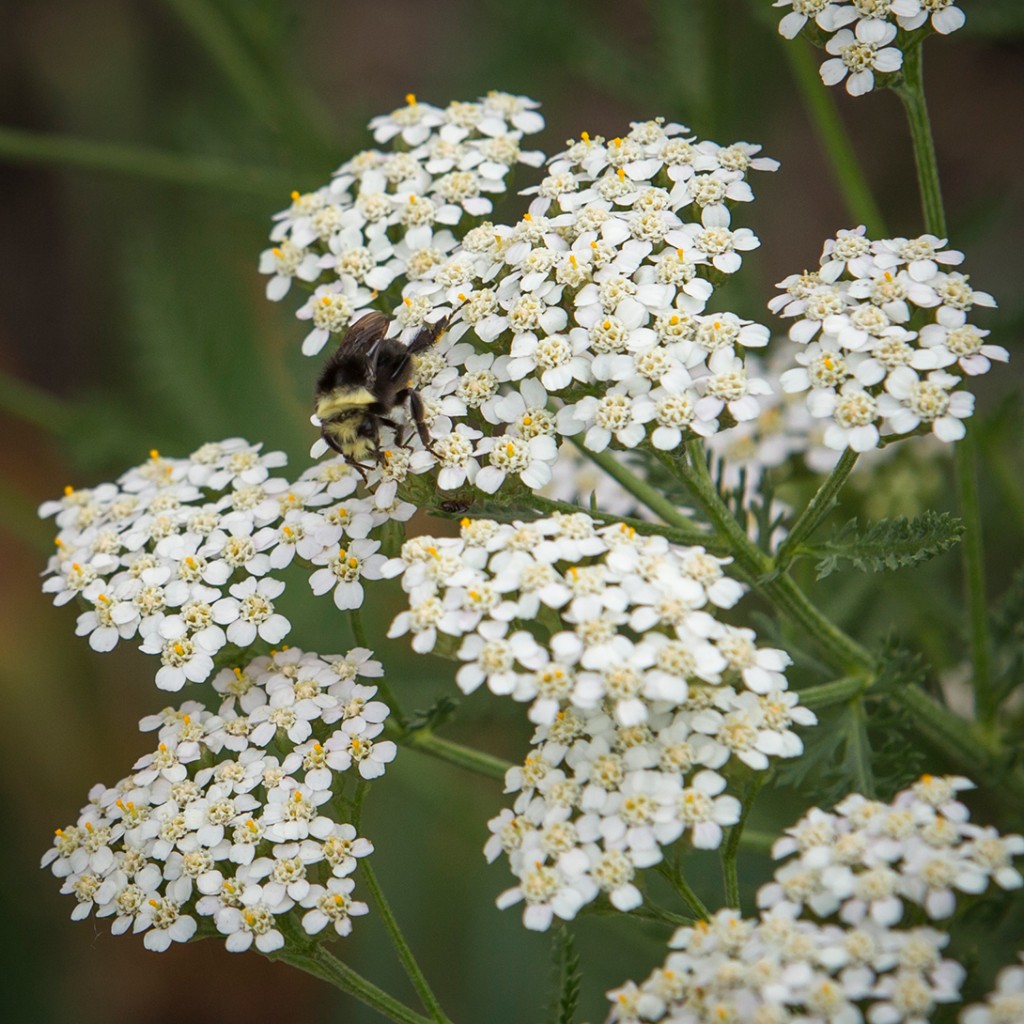Scientists know that bees are dying for a variety of reasons—pesticides, habitat destruction, drought, climate change, nutrition deficit, air pollution, and so on, which makes us the obvious perpetrator. We can help give back to them (and other pollinators) by growing flowering native plants in our gardens (as well as noninvasive exotics that step in when a native plant isn’t available or feasible), with consecutive blooms from early spring till fall. To provide for many different types of pollinators—from long and short-tongued bumblebees to syrphid flies, hummingbirds, and beetles—offer a variety of flower shapes, colors, and sizes, with smaller plants in groups of at least three of the same species (like a big, obvious “Eat Here” sign). Fragrance is also important for attracting insects to flowers and guiding them to food within the flower, and aiding an insect’s ability to efficiently learn particular food sources.
Below are some native perennials and one shrub that offer food for pollinators from mid or late summer to fall in the Pacific Northwest, west of the Cascades. There are more candidates, but I chose these species because they naturally occur in fairly large parts of the region, are generally easy to grow, and are not too hard to find at nurseries (although you will likely have to call around for availability). I’ve listed them alphabetically with some very basic care guidelines. It’s best to plant them in the fall, just before or as the rain returns.
As always, plan ahead and choose species that fit your light, moisture, and soil conditions, but also choose those that are appropriate to the natural landscape—that is, look to nearby natural areas, and add flora that would likely have grown in your area historically, if possible. You can also check a species’ natural range (to county level) here, or check with your local native plant society chapter or county soil and water conservation district. No fertilizer is necessary and please don’t use any pesticides. Keep them adequately hydrated—by watering deeply and infrequently to promote deep roots—until they’re established (2 to 5 years). Enjoy!
◊ Achillea millefolium var. occidentalis (Yarrow): Perennial. 1-3 feet tall x 1-3 feet wide. Sun to part sun. Not fussy about soil; moist or dry. Spreads by rhizomes or seed. Flat-topped clusters of white, fragrant flowers (pictured below) bloom through late summer. (Not to be confused with the Eurasian Achillea millefolium var. millefolium). 
◊ Anaphalis margaritacea (Pearly everlasting): Perennial. 1-3 feet tall x 1-2 feet wide. Sun to part shade. Likes moist soil with good drainage, but can tolerate drought once established. Pure white flowers are often used in dried flower arrangements. Besides providing nectar, it is a host plant for painted lady and skipper butterflies.
◊ Baccharis pilularis (Coyotebush): Evergreen or semi-evergreen shrub. 5-8 feet tall x 6-8 feet wide. Sun to part shade. Tolerates poor soils (but needs good drainage) and is drought tolerant. Flowers aren’t showy and are borne on separate male and female plants (male flowers creamy white; female pale green). Excellent wildlife habitat plant but is deer resistant.
 ◊ Campanula rotundifolia (common harebell): Perennial. 1-2 feet tall x 1-2 feet wide. Sun to part shade. Moist to dry, well-drained soil, preferably with a good amount of organic matter. Spreads slowly by rhizomes or seed. Bell-shaped, bluish violet flowers typically bloom through late summer. (pictured left)
◊ Campanula rotundifolia (common harebell): Perennial. 1-2 feet tall x 1-2 feet wide. Sun to part shade. Moist to dry, well-drained soil, preferably with a good amount of organic matter. Spreads slowly by rhizomes or seed. Bell-shaped, bluish violet flowers typically bloom through late summer. (pictured left)
◊ Gaillardia aristata (blanketflower): Perennial (short-lived). 1-3 feet tall x 1-3 feet wide. Sun to light shade. Tolerates a variety of well-drained soils; drought tolerant when established. Spreads by seed. Colorful yellow and reddish orange flowers bloom well into fall, especially when dead-headed. Deer resistant.
◊ Solidago canadensis (Goldenrod): Perennial. 2-4 feet tall x 2-3 feet wide. Sun to part shade.  Tolerates wide range of soils; prefers moisture but tolerates drought when established. Spreads by rhizomes or seed. Bright gold, fragrant inflorescences typically bloom well into fall. (pictured right)
Tolerates wide range of soils; prefers moisture but tolerates drought when established. Spreads by rhizomes or seed. Bright gold, fragrant inflorescences typically bloom well into fall. (pictured right)
◊ Symphyotrichum subspicatum (Douglas aster): Perennial. 2-3 feet tall x 2-3 feet wide. Sun to part shade. Does best in moist soil that is rich in organic matter. Spreads slowly by rhizomes and seed. Lavender-blue daisylike flowers bloom from mid summer until mid fall. (pictured below)

